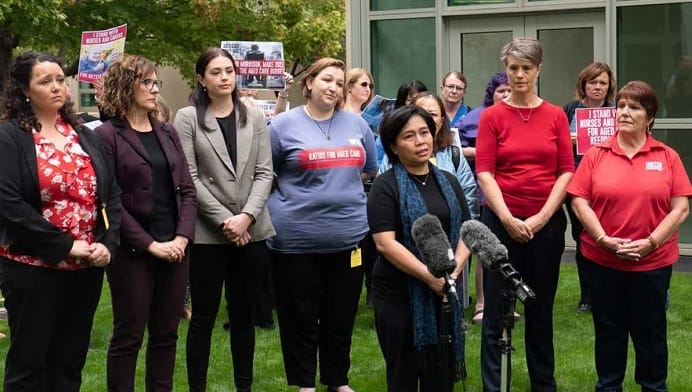COVID has hit lower-paid workers hardest, according to new research. Solidarity spoke to lead researcher Dr Tom Barnes from the Institute for Humanities and Social Sciences at the Australian Catholic University.
I think what the research found really confirms a lot of personal experiences from the pandemic that the pandemic had a greater impact on people’s lives in certain areas more so than others.
We looked at data from state health authorities and also data from agencies like the Australian Bureau of Statistics.
What we found is that the experiences of the pandemic were highly unequal. And in particular, we found that what underpins the experience of the pandemic has been high levels and widening levels of class inequality.
There are other kinds of inequality like gender inequality, which the report also talks about, but class inequality lay at the core of it.
What our model demonstrates is a direct cause and effect between the proportion of workers in blue-collar occupations in a local government area and case numbers.
So, for example, in Sydney during the Delta wave last year and the three to four-month lockdown, a 1 per cent increase in the proportion of blue-collar workers in a local government area (LGA) led to an additional 848 cases.
In Melbourne in the same period, an additional 1 per cent of blue-collar workers in an LGA led to an increase of 895 coronavirus case numbers.
And if you look at that spatially across each city, that impact was clearly felt in less advantaged areas more than others. So, in Sydney, there were 12 so-called LGAs of concern where the restrictions are much more severe, with 11 of those in the western suburbs.
Physical presence
One of those, Fairfield, has seven times more blue-collar workers than in a relatively affluent LGA like Woollahra in the eastern suburbs.
In Melbourne, Brimbank in the western suburbs has four times as many blue-collar workers as a relatively affluent LGA like Stonnington in the inner south-eastern suburbs.
So it’s in those areas, the western suburbs of Sydney, and the outer suburban, working-class suburbs of Melbourne, where case numbers were high.
The experience of the pandemic has been much worse, depending on where you live, what you do for work and this model demonstrates that formally.
Blue-collar workers are much more exposed to the coronavirus because of the nature of their work. They cannot work from home. They cannot work remotely. They have to maintain a physical presence to keep their jobs.
I’ve been interviewing a lot of workers about their experiences during the Delta wave in western Sydney, including women working in health care, child care and aged care. And again, the exposure to the coronavirus, plus the social and economic impacts of lockdowns, are much more severe for these types of workers.
Born overseas
Our report also looked at the situation for people born overseas, who primarily speak a language other than English in the in their households. That’s a very large proportion of the labour force. In Victoria, we’d be talking about probably a third of the workforce.
Again, we found a relationship between LGAs with a high proportion of non-English speaking migrants and coronavirus case numbers, as well as relatively low vaccination rates.
In Sydney, every 1 per cent increase in non-English speaking migrants in an LGA led to an increase of 609 coronavirus case numbers during the Delta wave. The increase in Melbourne was 642.
If you look at LGAs like Canterbury-Bankstown or Fairfield in Sydney, or Hume, Brimbank or Whittlesea in Melbourne, these areas tend to be dominated in terms of population by working class people who are either first or second-generation migrants from non-English speaking backgrounds. So there’s an overlap, a very strong overlap, between ethnicity and class.
Impact on women
In all this, the impact on women has been much sharper. So, if you look at some of the economic data, there has been a lot of talk in the media for quite a while about miraculously low levels of unemployment.
But what that masks is a dramatic decline in total employment and in the size of the labour force. So, in Sydney, during the Delta wave the total labour force declined by 8 per cent, similar to the fall experienced after the first wave in March 2020. For women, the decline in the labour force was 9 per cent.
That’s before we mention the unequal impacts of lockdowns in terms of school closures and the pressures of home schooling.
So the experience for many women during the pandemic was worse—but it was far worse for those women working in highly exposed sectors such as home care, aged care, and early childhood education and care. And worse for those women working in LGAs of concern where the restrictions were much more severe.
Domestic violence
It’s not part of this report but I’ve spoken to a few organisations involved in directly assisting women and kids who are victims of domestic violence.
It appears that the pandemic has had a significant impact on both the rates of domestic violence and the experience of domestic violence. A new report suggests that one in 12 women who have a live-in partner experience some form of physical violence. That’s an extraordinary statistic. And that was reported during the beginning of the pandemic.
There is a lot of qualitative evidence that suggests domestic violence has become worse as a consequence of the social and economic pressures of the pandemic and lockdowns.
So, for example, women who live in a domestic situation in which they previously experienced psychological or emotional abuse were reporting that the perpetrator would be more likely to have shifted into more overtly physical forms of violence.
In some cases, perpetrators of domestic violence would use lockdown rules as an added way to control their partner physically or emotionally by saying: “You’re not allowed to leave the house. You can’t escape.”
In the coming period, unions and other social movements will have a strong focus on getting rid of the Liberal government, and that’s right.
But I also think there are a range of more immediate issues that we need to fight around. We need free RATs. There are important demands around fixing up the vaccination stuff-up.
And we need to demand that JobSeeker is a liveable income. We know the choice to keep JobSeeker low is a political and deliberate one.
So I think demands around increasing the JobSeeker rate will also continue to be important alongside demands around vaccines, RATs as well as the overarching question of a change of government.
Listen to the interview in full, below.






